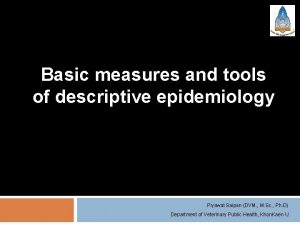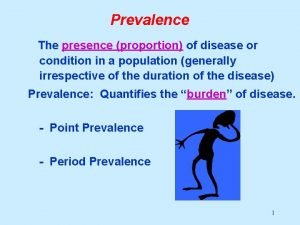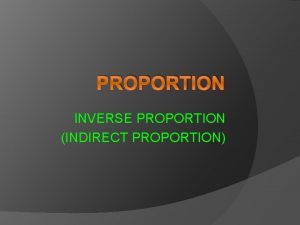Epidemiology FATMA KHALIFA Defination Prevalence is the proportion









- Slides: 9

Epidemiology FATMA KHALIFA

Defination Prevalence is the proportion of a particular population found to be affected by a medical condition

Difference between incidence &prevalence • Prevalence is the number of disease cases present in a particular population at a given time. • incidence is the number of new cases that develop during a specified time period. • Prevalence answers "How many people have this disease right now? " or "How many people have had this disease during this time period? ". Incidence answers "How many people acquired the disease during a specified time period".

Type of prevalence Lifetime prevalence Period prevalence Point prevalence

Lifetime prevalence • Lifetime prevalence (LTP) is the proportion of individuals in a population that at some point in their life (up to the time of assessment) have experienced a "case", e. g. , a disease; a traumatic event; or a behavior, such as committing a crime. Often, a 12 -month prevalence (or some other type of "period prevalence") is provided in conjunction with lifetime prevalence. Point prevalence is the prevalence of disorder at a specific point in time (a month or less). Lifetime morbid risk is "the proportion of a population that might become afflicted with a given disease at any point in their lifetime. "

Period prevalence • Period prevalence is the proportion of the population with a given disease or condition over a specific period of time. • It could describe how many people in a population had a cold over the cold season in 2006, for example. It is expressed as a percentage of the population and can be described by the following formula: • Period prevalence (proportion) = Number of cases that existed in a given period ÷ Number of people in the population during this period

Point prevalence is a measure of the proportion of people in a population who have a disease or condition at a particular time, such as a particular date. It is like a snapshot of the disease in time. It can be used for statistics on the occurrence of chronic disease. This is in contrast to period prevalence. Point prevalence can be described by the formula: Prevalence = Number of existing cases on a specific date ÷ Number of people in the population on this date.

Period prevalence Point prevalence is a measure of the proportion of people in a population who have a disease or condition over a specific period of time, as season, or a year. is a measure of the proportion of people in a population who have a disease or condition at a particular time, such as a particular date

• The relationship between incidence (rate), point prevalence (ratio) and period prevalence (ratio) is easily explained via an analogy with photography. • Point prevalence is close to a flashlit photograph: what is happening at this instant frozen in time. • Period prevalence is analogous to a long exposure (seconds, rather than an instant) photograph: the number of events recorded in the photo whilst the camera shutter was open. • In a movie each frame records an instant (point prevalence); by looking from frame to frame one notices new events (incident events) and can relate the number of such events to a period (number of frames).
















